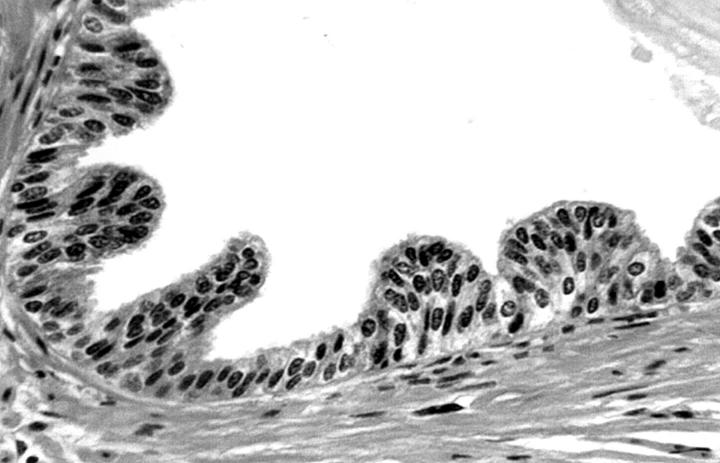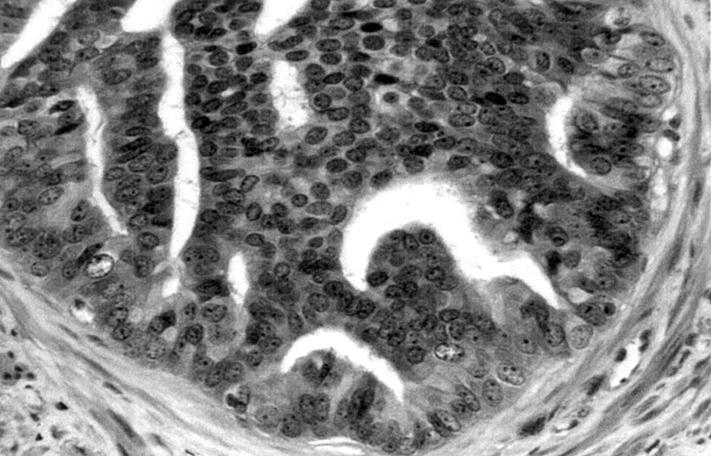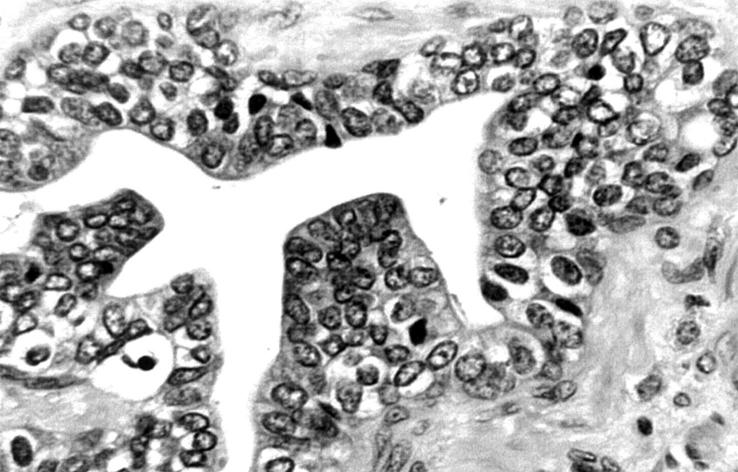Abstract
High grade prostatic intraepithelial neoplasia (PIN) is the most likely precursor of prostatic carcinoma. PIN has a high predictive value as a marker for carcinoma, and its identification in biopsy specimens warrants repeat biopsy for concurrent or subsequent carcinoma. The only methods of detection are biopsy and transurethral resection; PIN does not greatly raise the concentration of serum prostate specific antigen (PSA) or its derivatives, does not induce a palpable mass, and cannot be detected by ultrasound. Androgen deprivation decreases the prevalence and extent of PIN, suggesting that this form of treatment might play a role in chemoprevention. Radiotherapy is also associated with a decreased incidence of PIN.
Key Words: prostate • prostatic intraepithelial neoplasia • intraductal dysplasia • intraductal carcinoma • atypical adenomatous hyperplasia • prostatic adenocarcinoma • chemoprevention
Full Text
The Full Text of this article is available as a PDF (235.9 KB).
Figure 1 Normal prostate. The duct is lined by a two cell layer—for example, the basal cell and the secretory or lumenal cell layers.
Figure 2 Low grade prostatic intraepithelial neoplasia. The nuclei of the secretory cells are enlarged, vary in size, have a normal or slightly increased chromatin content, and possess small or inconspicuous nucleoli. The basal cell layer is almost intact.
Figure 3 High grade prostatic intraepithelial neoplasia with cribriform pattern. The perimeter cells show features of clearly dysplastic cells, whereas, going from the periphery towards the centre, the nuclei become smaller and the nucleoli become less apparent ("maturation phenomenon"). The basal cell layer is disrupted.
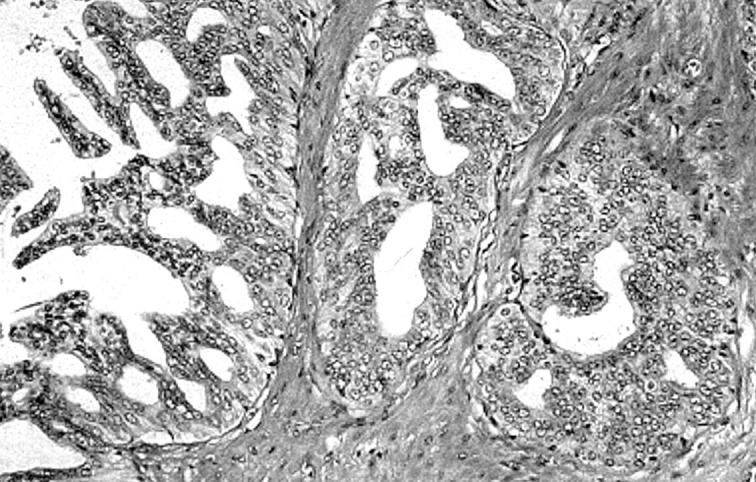
Figure 4 Inraductal carcinoma. The glandular unit is filled by a cell mass perforated by crisp, neatly punched out spaces of regular size.
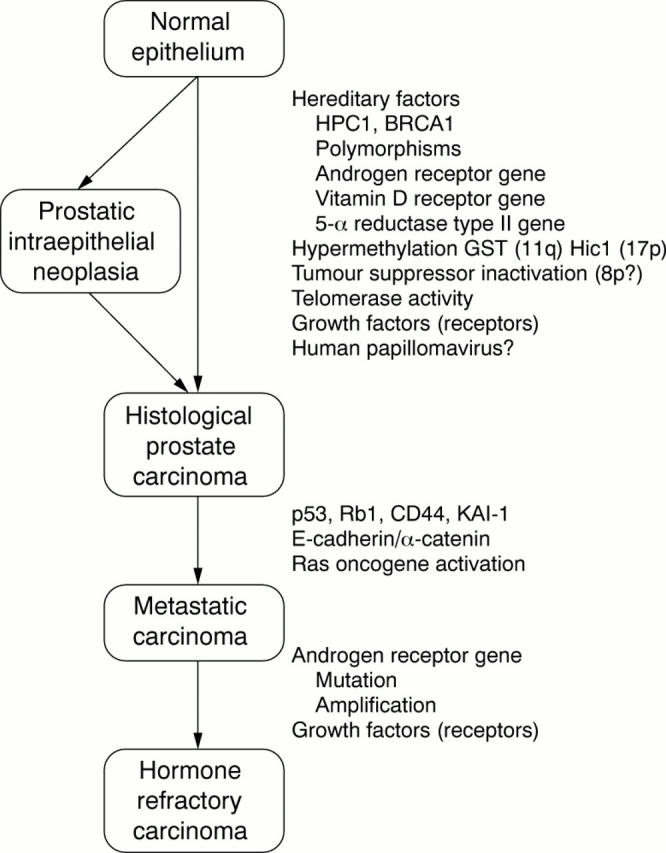
Figure 5 Transition from normal epithelium to prostate cancer with and without an intermediate morphological stage identifiable as prostatic intraepithelial neoplasia.49 GST, glutathione S-transferase; Rb1, retinoblastoma 1.
Figure 6 Prostatic intraepithelial neoplasia (PIN) following androgen ablation. Secretory cell type stratification is present. However, crowding is less evident than in untreated high grade PIN. The cells show cytoplasmic clearing and enlargement as a result of the coalescence of vacuoles and the rupture of cell membranes. The nucleoli are inconspicuous.
Figure 7 High grade prostatic intraepithelial neoplasia with early invasion. Direct invasion into the stroma by a small tubular malignant gland, which appeared to originate abruptly from a dysplastic duct wall (arrow).
Selected References
These references are in PubMed. This may not be the complete list of references from this article.
- Aboseif S., Shinohara K., Weidner N., Narayan P., Carroll P. R. The significance of prostatic intra-epithelial neoplasia. Br J Urol. 1995 Sep;76(3):355–359. doi: 10.1111/j.1464-410x.1995.tb07714.x. [DOI] [PubMed] [Google Scholar]
- Akakura K., Bruchovsky N., Goldenberg S. L., Rennie P. S., Buckley A. R., Sullivan L. D. Effects of intermittent androgen suppression on androgen-dependent tumors. Apoptosis and serum prostate-specific antigen. Cancer. 1993 May 1;71(9):2782–2790. doi: 10.1002/1097-0142(19930501)71:9<2782::aid-cncr2820710916>3.0.co;2-z. [DOI] [PubMed] [Google Scholar]
- Alers J. C., Krijtenburg P. J., Vissers K. J., Bosman F. T., van der Kwast T. H., van Dekken H. Interphase cytogenetics of prostatic adenocarcinoma and precursor lesions: analysis of 25 radical prostatectomies and 17 adjacent prostatic intraepithelial neoplasias. Genes Chromosomes Cancer. 1995 Apr;12(4):241–250. doi: 10.1002/gcc.2870120402. [DOI] [PubMed] [Google Scholar]
- Algaba F., Epstein J. I., Fabus G., Helpap B., Nagle R. B., Polito M. Working standards in prostatic intraepithelial neoplasia and atypical adenomatous hyperplasia. Pathol Res Pract. 1995 Sep;191(9):836–837. doi: 10.1016/S0344-0338(11)80964-7. [DOI] [PubMed] [Google Scholar]
- Algaba F., Trias I. Diagnostic limits in precursor lesions of prostatic cancer. Eur Urol. 1996;30(2):212–221. doi: 10.1159/000474172. [DOI] [PubMed] [Google Scholar]
- Algaba F., Trias I., Lopez L., Rodriguez-Vallejo J. M., Gonzalez-Esteban J. Neuroendocrine cells in peripheral prostatic zone: age, prostatic intraepithelial neoplasia and latent cancer-related changes. Eur Urol. 1995;27(4):329–333. doi: 10.1159/000475191. [DOI] [PubMed] [Google Scholar]
- Allam C. K., Bostwick D. G., Hayes J. A., Upton M. P., Wade G. G., Domanowski G. F., Klein M. A., Boling E. A., Stilmant M. M. Interobserver variability in the diagnosis of high-grade prostatic intraepithelial neoplasia and adenocarcinoma. Mod Pathol. 1996 Jul;9(7):742–751. [PubMed] [Google Scholar]
- Amin M. B., Ro J. Y., Ayala A. G. Putative precursor lesions of prostatic adenocarcinoma: fact or fiction? Mod Pathol. 1993 Jul;6(4):476–483. [PubMed] [Google Scholar]
- Amin M. B., Schultz D. S., Zarbo R. J. Analysis of cribriform morphology in prostatic neoplasia using antibody to high-molecular-weight cytokeratins. Arch Pathol Lab Med. 1994 Mar;118(3):260–264. [PubMed] [Google Scholar]
- Andrews G. S. Latent Carcinoma of the Prostate. J Clin Pathol. 1949 Aug;2(3):197–208. doi: 10.1136/jcp.2.3.197. [DOI] [PMC free article] [PubMed] [Google Scholar]
- Armas O. A., Aprikian A. G., Melamed J., Cordon-Cardo C., Cohen D. W., Erlandson R., Fair W. R., Reuter V. E. Clinical and pathobiological effects of neoadjuvant total androgen ablation therapy on clinically localized prostatic adenocarcinoma. Am J Surg Pathol. 1994 Oct;18(10):979–991. doi: 10.1097/00000478-199410000-00002. [DOI] [PubMed] [Google Scholar]
- Baylin S. B., Makos M., Wu J. J., Yen R. W., de Bustros A., Vertino P., Nelkin B. D. Abnormal patterns of DNA methylation in human neoplasia: potential consequences for tumor progression. Cancer Cells. 1991 Oct;3(10):383–390. [PubMed] [Google Scholar]
- Bergerheim U. S., Kunimi K., Collins V. P., Ekman P. Deletion mapping of chromosomes 8, 10, and 16 in human prostatic carcinoma. Genes Chromosomes Cancer. 1991 May;3(3):215–220. doi: 10.1002/gcc.2870030308. [DOI] [PubMed] [Google Scholar]
- Berman D. M., Yang J., Epstein J. I. Foamy gland high-grade prostatic intraepithelial neoplasia. Am J Surg Pathol. 2000 Jan;24(1):140–144. doi: 10.1097/00000478-200001000-00018. [DOI] [PubMed] [Google Scholar]
- Berner A., Danielsen H. E., Pettersen E. O., Fosså S. D., Reith A., Nesland J. M. DNA distribution in the prostate. Normal gland, benign and premalignant lesions, and subsequent adenocarcinomas. Anal Quant Cytol Histol. 1993 Aug;15(4):247–252. [PubMed] [Google Scholar]
- Bock B. J., Bostwick D. G. Does prostatic ductal adenocarcinoma exist? Am J Surg Pathol. 1999 Jul;23(7):781–785. doi: 10.1097/00000478-199907000-00005. [DOI] [PubMed] [Google Scholar]
- Bostwick D. G., Amin M. B., Dundore P., Marsh W., Schultz D. S. Architectural patterns of high-grade prostatic intraepithelial neoplasia. Hum Pathol. 1993 Mar;24(3):298–310. doi: 10.1016/0046-8177(93)90041-e. [DOI] [PubMed] [Google Scholar]
- Bostwick D. G., Brawer M. K. Prostatic intra-epithelial neoplasia and early invasion in prostate cancer. Cancer. 1987 Feb 15;59(4):788–794. doi: 10.1002/1097-0142(19870215)59:4<788::aid-cncr2820590421>3.0.co;2-i. [DOI] [PubMed] [Google Scholar]
- Bostwick D. G., Dousa M. K., Crawford B. G., Wollan P. C. Neuroendocrine differentiation in prostatic intraepithelial neoplasia and adenocarcinoma. Am J Surg Pathol. 1994 Dec;18(12):1240–1246. doi: 10.1097/00000478-199412000-00007. [DOI] [PubMed] [Google Scholar]
- Bostwick D. G., Iczkowski K. A. Minimal criteria for the diagnosis of prostate cancer on needle biopsy. Ann Diagn Pathol. 1997 Dec;1(2):104–129. doi: 10.1016/s1092-9134(97)80015-9. [DOI] [PubMed] [Google Scholar]
- Bostwick D. G., Kindrachuk R. W., Rouse R. V. Prostatic adenocarcinoma with endometrioid features. Clinical, pathologic, and ultrastructural findings. Am J Surg Pathol. 1985 Aug;9(8):595–609. doi: 10.1097/00000478-198508000-00004. [DOI] [PubMed] [Google Scholar]
- Bova G. S., Carter B. S., Bussemakers M. J., Emi M., Fujiwara Y., Kyprianou N., Jacobs S. C., Robinson J. C., Epstein J. I., Walsh P. C. Homozygous deletion and frequent allelic loss of chromosome 8p22 loci in human prostate cancer. Cancer Res. 1993 Sep 1;53(17):3869–3873. [PubMed] [Google Scholar]
- Brawer M. K., Bigler S. A., Sohlberg O. E., Nagle R. B., Lange P. H. Significance of prostatic intraepithelial neoplasia on prostate needle biopsy. Urology. 1991 Aug;38(2):103–107. doi: 10.1016/s0090-4295(05)80067-6. [DOI] [PubMed] [Google Scholar]
- Böhm N., Sandritter W. DNA in human tumors: a cytophotometric study. Curr Top Pathol. 1975;60:151–219. doi: 10.1007/978-3-642-66215-7_5. [DOI] [PubMed] [Google Scholar]
- Cheng L., Cheville J. C., Pisansky T. M., Sebo T. J., Slezak J., Bergstralh E. J., Neumann R. M., Singh R., Pacelli A., Zincke H. Prevalence and distribution of prostatic intraepithelial neoplasia in salvage radical prostatectomy specimens after radiation therapy. Am J Surg Pathol. 1999 Jul;23(7):803–808. doi: 10.1097/00000478-199907000-00008. [DOI] [PubMed] [Google Scholar]
- Cunningham J. M., Shan A., Wick M. J., McDonnell S. K., Schaid D. J., Tester D. J., Qian J., Takahashi S., Jenkins R. B., Bostwick D. G. Allelic imbalance and microsatellite instability in prostatic adenocarcinoma. Cancer Res. 1996 Oct 1;56(19):4475–4482. [PubMed] [Google Scholar]
- Davidson D., Bostwick D. G., Qian J., Wollan P. C., Oesterling J. E., Rudders R. A., Siroky M., Stilmant M. Prostatic intraepithelial neoplasia is a risk factor for adenocarcinoma: predictive accuracy in needle biopsies. J Urol. 1995 Oct;154(4):1295–1299. [PubMed] [Google Scholar]
- Emmert-Buck M. R., Vocke C. D., Pozzatti R. O., Duray P. H., Jennings S. B., Florence C. D., Zhuang Z., Bostwick D. G., Liotta L. A., Linehan W. M. Allelic loss on chromosome 8p12-21 in microdissected prostatic intraepithelial neoplasia. Cancer Res. 1995 Jul 15;55(14):2959–2962. [PubMed] [Google Scholar]
- Epstein J. I., Cho K. R., Quinn B. D. Relationship of severe dysplasia to stage A (incidental) adenocarcinoma of the prostate. Cancer. 1990 May 15;65(10):2321–2327. doi: 10.1002/1097-0142(19900515)65:10<2321::aid-cncr2820651026>3.0.co;2-b. [DOI] [PubMed] [Google Scholar]
- Epstein J. I., Grignon D. J., Humphrey P. A., McNeal J. E., Sesterhenn I. A., Troncoso P., Wheeler T. M. Interobserver reproducibility in the diagnosis of prostatic intraepithelial neoplasia. Am J Surg Pathol. 1995 Aug;19(8):873–886. doi: 10.1097/00000478-199508000-00002. [DOI] [PubMed] [Google Scholar]
- Ferguson J., Zincke H., Ellison E., Bergstrahl E., Bostwick D. G. Decrease of prostatic intraepithelial neoplasia following androgen deprivation therapy in patients with stage T3 carcinoma treated by radical prostatectomy. Urology. 1994 Jul;44(1):91–95. doi: 10.1016/s0090-4295(94)80015-4. [DOI] [PubMed] [Google Scholar]
- Gaudin P. B., Sesterhenn I. A., Wojno K. J., Mostofi F. K., Epstein J. I. Incidence and clinical significance of high-grade prostatic intraepithelial neoplasia in TURP specimens. Urology. 1997 Apr;49(4):558–563. doi: 10.1016/s0090-4295(96)00542-0. [DOI] [PubMed] [Google Scholar]
- Haddad F. S. Re: Risk factors for perineal seeding of prostate cancer after needle biopsy. J Urol. 1990 Mar;143(3):587–588. doi: 10.1016/s0022-5347(17)40032-2. [DOI] [PubMed] [Google Scholar]
- Harvei S., Skjørten F. J., Robsahm T. E., Berner A., Tretli S. Is prostatic intraepithelial neoplasia in the transition/central zone a true precursor of cancer? A long-term retrospective study in Norway. Br J Cancer. 1998 Jul;78(1):46–49. doi: 10.1038/bjc.1998.440. [DOI] [PMC free article] [PubMed] [Google Scholar]
- Jarrard D. F., Bova G. S., Isaacs W. B. DNA methylation, molecular genetic, and linkage studies in prostate cancer. Prostate Suppl. 1996;6:36–44. [PubMed] [Google Scholar]
- Johnson M. I., Robinson M. C., Marsh C., Robson C. N., Neal D. E., Hamdy F. C. Expression of Bcl-2, Bax, and p53 in high-grade prostatic intraepithelial neoplasia and localized prostate cancer: relationship with apoptosis and proliferation. Prostate. 1998 Dec 1;37(4):223–229. doi: 10.1002/(sici)1097-0045(19981201)37:4<223::aid-pros3>3.0.co;2-o. [DOI] [PubMed] [Google Scholar]
- Kallakury B. V., Brien T. P., Lowry C. V., Muraca P. J., Fisher H. A., Kaufman R. P., Jr, Ross J. S. Telomerase activity in human benign prostate tissue and prostatic adenocarcinomas. Diagn Mol Pathol. 1997 Aug;6(4):192–198. doi: 10.1097/00019606-199708000-00003. [DOI] [PubMed] [Google Scholar]
- Keetch D. W., Humphrey P., Stahl D., Smith D. S., Catalona W. J. Morphometric analysis and clinical followup of isolated prostatic intraepithelial neoplasia in needle biopsy of the prostate. J Urol. 1995 Aug;154(2 Pt 1):347–351. doi: 10.1097/00005392-199508000-00003. [DOI] [PubMed] [Google Scholar]
- Kovi J., Jackson M. A., Heshmat M. Y. Ductal spread in prostatic carcinoma. Cancer. 1985 Oct 1;56(7):1566–1573. doi: 10.1002/1097-0142(19851001)56:7<1566::aid-cncr2820560717>3.0.co;2-y. [DOI] [PubMed] [Google Scholar]
- Kovi J., Mostofi F. K., Heshmat M. Y., Enterline J. P. Large acinar atypical hyperplasia and carcinoma of the prostate. Cancer. 1988 Feb 1;61(3):555–561. doi: 10.1002/1097-0142(19880201)61:3<555::aid-cncr2820610322>3.0.co;2-h. [DOI] [PubMed] [Google Scholar]
- Langer J. E., Rovner E. S., Coleman B. G., Yin D., Arger P. H., Malkowicz S. B., Nisenbaum H. L., Rowling S. E., Tomaszewski J. E., Wein A. J. Strategy for repeat biopsy of patients with prostatic intraepithelial neoplasia detected by prostate needle biopsy. J Urol. 1996 Jan;155(1):228–231. [PubMed] [Google Scholar]
- Lee F., Torp-Pedersen S. T., Carroll J. T., Siders D. B., Christensen-Day C., Mitchell A. E. Use of transrectal ultrasound and prostate-specific antigen in diagnosis of prostatic intraepithelial neoplasia. Urology. 1989 Dec;34(6 Suppl):4–8. [PubMed] [Google Scholar]
- Lee W. H., Morton R. A., Epstein J. I., Brooks J. D., Campbell P. A., Bova G. S., Hsieh W. S., Isaacs W. B., Nelson W. G. Cytidine methylation of regulatory sequences near the pi-class glutathione S-transferase gene accompanies human prostatic carcinogenesis. Proc Natl Acad Sci U S A. 1994 Nov 22;91(24):11733–11737. doi: 10.1073/pnas.91.24.11733. [DOI] [PMC free article] [PubMed] [Google Scholar]
- MacGrogan D., Levy A., Bostwick D., Wagner M., Wells D., Bookstein R. Loss of chromosome arm 8p loci in prostate cancer: mapping by quantitative allelic imbalance. Genes Chromosomes Cancer. 1994 Jul;10(3):151–159. doi: 10.1002/gcc.2870100302. [DOI] [PubMed] [Google Scholar]
- Magi Galluzzi C., Montironi R., Giannulis I., Diamanti L., Scarpelli M., Muzzonigro G., Polito M. Prostatic invasive adenocarcinoma. Effect of combination endocrine therapy (LHRH agonist and flutamide) on the expression and location of proliferating cell nuclear antigen (PCNA). Pathol Res Pract. 1993 Dec;189(10):1154–1160. doi: 10.1016/S0344-0338(11)80838-1. [DOI] [PubMed] [Google Scholar]
- Markham C. W. Prostatic intraepithelial neoplasia: detection and correlation with invasive cancer in fine-needle biopsy. Urology. 1989 Dec;34(6 Suppl):57–61. [PubMed] [Google Scholar]
- McNeal J. E., Bostwick D. G. Intraductal dysplasia: a premalignant lesion of the prostate. Hum Pathol. 1986 Jan;17(1):64–71. doi: 10.1016/s0046-8177(86)80156-3. [DOI] [PubMed] [Google Scholar]
- McNeal J. E., Haillot O., Yemoto C. Cell proliferation in dysplasia of the prostate: analysis by PCNA immunostaining. Prostate. 1995 Nov;27(5):258–268. doi: 10.1002/pros.2990270505. [DOI] [PubMed] [Google Scholar]
- McNeal J. E. Morphogenesis of prostatic carcinoma. Cancer. 1965 Dec;18(12):1659–1666. doi: 10.1002/1097-0142(196512)18:12<1659::aid-cncr2820181223>3.0.co;2-i. [DOI] [PubMed] [Google Scholar]
- McNeal J. E., Reese J. H., Redwine E. A., Freiha F. S., Stamey T. A. Cribriform adenocarcinoma of the prostate. Cancer. 1986 Oct 15;58(8):1714–1719. doi: 10.1002/1097-0142(19861015)58:8<1714::aid-cncr2820580823>3.0.co;2-m. [DOI] [PubMed] [Google Scholar]
- McNeal J. E. Significance of duct-acinar dysplasia in prostatic carcinogenesis. Prostate. 1988;13(2):91–102. doi: 10.1002/pros.2990130202. [DOI] [PubMed] [Google Scholar]
- McNeal J. E., Villers A., Redwine E. A., Freiha F. S., Stamey T. A. Microcarcinoma in the prostate: its association with duct-acinar dysplasia. Hum Pathol. 1991 Jul;22(7):644–652. doi: 10.1016/0046-8177(91)90286-x. [DOI] [PubMed] [Google Scholar]
- McNeal J. E., Yemoto C. E. Spread of adenocarcinoma within prostatic ducts and acini. Morphologic and clinical correlations. Am J Surg Pathol. 1996 Jul;20(7):802–814. doi: 10.1097/00000478-199607000-00003. [DOI] [PubMed] [Google Scholar]
- Mettlin C., Lee F., Drago J., Murphy G. P. The American Cancer Society National Prostate Cancer Detection Project. Findings on the detection of early prostate cancer in 2425 men. Cancer. 1991 Jun 15;67(12):2949–2958. doi: 10.1002/1097-0142(19910615)67:12<2949::aid-cncr2820671202>3.0.co;2-x. [DOI] [PubMed] [Google Scholar]
- Montironi R., Galluzzi C. M., Diamanti L., Taborro R., Scarpelli M., Pisani E. Prostatic intra-epithelial neoplasia. Qualitative and quantitative analyses of the blood capillary architecture on thin tissue sections. Pathol Res Pract. 1993 Jun;189(5):542–548. [PubMed] [Google Scholar]
- Montironi R., Hamilton P. W., Scarpelli M., Thompson D., Bartels P. H. Subtle morphological and molecular changes in normal-looking epithelium in prostates with prostatic intraepithelial neoplasia or cancer. Eur Urol. 1999;35(5-6):468–473. doi: 10.1159/000019881. [DOI] [PubMed] [Google Scholar]
- Montironi R., Mazzucchelli R., Marshall J. R., Bartels P. H. Prostate cancer prevention: review of target populations, pathological biomarkers, and chemopreventive agents. J Clin Pathol. 1999 Nov;52(11):793–803. doi: 10.1136/jcp.52.11.793. [DOI] [PMC free article] [PubMed] [Google Scholar]
- Montironi R., Mazzucchelli R., Santinelli A., Hamilton P. W., Thompson D., Bartels P. H. Case diagnosis as positive identification in prostatic neoplasia. Anal Quant Cytol Histol. 1998 Oct;20(5):424–436. [PubMed] [Google Scholar]
- Montironi R., Mazzucchelli R., Stramazzotti D., Pomante R., Thompson D., Bartels P. H. Expression of pi-class glutathione S-transferase: two populations of high grade prostatic intraepithelial neoplasia with different relations to carcinoma. Mol Pathol. 2000 Jun;53(3):122–128. doi: 10.1136/mp.53.3.122. [DOI] [PMC free article] [PubMed] [Google Scholar]
- Montironi R., Pomante R., Diamanti L., Hamilton P. W., Thompson D., Bartels P. H. Evaluation of prostatic intraepithelial neoplasia after treatment with a 5-alpha-reductase inhibitor (finasteride). A methodologic approach. Anal Quant Cytol Histol. 1996 Dec;18(6):461–470. [PubMed] [Google Scholar]
- Montironi R., Schulman C. C. Pathological changes in prostate lesions after androgen manipulation. J Clin Pathol. 1998 Jan;51(1):5–12. doi: 10.1136/jcp.51.1.5. [DOI] [PMC free article] [PubMed] [Google Scholar]
- Noordzij M. A., van Steenbrugge G. J., van der Kwast T. H., Schröder F. H. Neuroendocrine cells in the normal, hyperplastic and neoplastic prostate. Urol Res. 1995;22(6):333–341. doi: 10.1007/BF00296871. [DOI] [PubMed] [Google Scholar]
- Oertel H. An Address on Involutionary Changes in Prostate and Female Breast in Relation to Cancer Development. Can Med Assoc J. 1926 Mar;16(3):237–241. [PMC free article] [PubMed] [Google Scholar]
- Pacelli A., Bostwick D. G. Clinical significance of high-grade prostatic intraepithelial neoplasia in transurethral resection specimens. Urology. 1997 Sep;50(3):355–359. doi: 10.1016/S0090-4295(97)00249-5. [DOI] [PubMed] [Google Scholar]
- Parkinson M. C. Pre-neoplastic lesions of the prostate. Histopathology. 1995 Oct;27(4):301–311. doi: 10.1111/j.1365-2559.1995.tb01520.x. [DOI] [PubMed] [Google Scholar]
- Pretlow T. G., Nagabhushan M., Pretlow T. P. Prostatic intraepithelial neoplasia and other changes during promotion and progression. Pathol Res Pract. 1995 Sep;191(9):842–849. doi: 10.1016/S0344-0338(11)80966-0. [DOI] [PubMed] [Google Scholar]
- Qian J., Bostwick D. G., Takahashi S., Borell T. J., Herath J. F., Lieber M. M., Jenkins R. B. Chromosomal anomalies in prostatic intraepithelial neoplasia and carcinoma detected by fluorescence in situ hybridization. Cancer Res. 1995 Nov 15;55(22):5408–5414. [PubMed] [Google Scholar]
- Qian J., Bostwick D. G., Takahashi S., Borell T. J., Herath J. F., Lieber M. M., Jenkins R. B. Chromosomal anomalies in prostatic intraepithelial neoplasia and carcinoma detected by fluorescence in situ hybridization. Cancer Res. 1995 Nov 15;55(22):5408–5414. [PubMed] [Google Scholar]
- Qian J., Bostwick D. G. The extent and zonal location of prostatic intraepithelial neoplasia and atypical adenomatous hyperplasia: relationship with carcinoma in radical prostatectomy specimens. Pathol Res Pract. 1995 Sep;191(9):860–867. doi: 10.1016/S0344-0338(11)80969-6. [DOI] [PubMed] [Google Scholar]
- Qian J., Jenkins R. B., Bostwick D. G. Detection of chromosomal anomalies and c-myc gene amplification in the cribriform pattern of prostatic intraepithelial neoplasia and carcinoma by fluorescence in situ hybridization. Mod Pathol. 1997 Nov;10(11):1113–1119. [PubMed] [Google Scholar]
- Qian J., Jenkins R. B., Bostwick D. G. Potential markers of aggressiveness in prostatic intraepithelial neoplasia detected by fluorescence in situ hybridization. Eur Urol. 1996;30(2):177–184. doi: 10.1159/000474167. [DOI] [PubMed] [Google Scholar]
- Qian J., Wollan P., Bostwick D. G. The extent and multicentricity of high-grade prostatic intraepithelial neoplasia in clinically localized prostatic adenocarcinoma. Hum Pathol. 1997 Feb;28(2):143–148. doi: 10.1016/s0046-8177(97)90097-6. [DOI] [PubMed] [Google Scholar]
- Quinn B. D., Cho K. R., Epstein J. I. Relationship of severe dysplasia to stage B adenocarcinoma of the prostate. Cancer. 1990 May 15;65(10):2328–2337. doi: 10.1002/1097-0142(19900515)65:10<2328::aid-cncr2820651027>3.0.co;2-o. [DOI] [PubMed] [Google Scholar]
- Raviv G., Zlotta A. R., Janssen T. h., Descamps F., Vanegas J. P., Verhest A., Schulman C. C. Do prostate specific antigen and prostate specific antigen density enhance the detection of prostate carcinoma after initial diagnosis of prostatic intraepithelial neoplasia without concurrent carcinoma? Cancer. 1996 May 15;77(10):2103–2108. doi: 10.1002/(SICI)1097-0142(19960515)77:10<2103::AID-CNCR21>3.0.CO;2-Y. [DOI] [PubMed] [Google Scholar]
- Reyes A. O., Swanson P. E., Carbone J. M., Humphrey P. A. Unusual histologic types of high-grade prostatic intraepithelial neoplasia. Am J Surg Pathol. 1997 Oct;21(10):1215–1222. doi: 10.1097/00000478-199710000-00013. [DOI] [PubMed] [Google Scholar]
- Rubin M. A., de La Taille A., Bagiella E., Olsson C. A., O'Toole K. M. Cribriform carcinoma of the prostate and cribriform prostatic intraepithelial neoplasia: incidence and clinical implications. Am J Surg Pathol. 1998 Jul;22(7):840–848. doi: 10.1097/00000478-199807000-00006. [DOI] [PubMed] [Google Scholar]
- Ruijter E., van de Kaa C., Miller G., Ruiter D., Debruyne F., Schalken J. Molecular genetics and epidemiology of prostate carcinoma. Endocr Rev. 1999 Feb;20(1):22–45. doi: 10.1210/edrv.20.1.0356. [DOI] [PubMed] [Google Scholar]
- Sakr W. A., Grignon D. J., Haas G. P., Heilbrun L. K., Pontes J. E., Crissman J. D. Age and racial distribution of prostatic intraepithelial neoplasia. Eur Urol. 1996;30(2):138–144. doi: 10.1159/000474163. [DOI] [PubMed] [Google Scholar]
- Sakr W. A., Macoska J. A., Benson P., Grignon D. J., Wolman S. R., Pontes J. E., Crissman J. D. Allelic loss in locally metastatic, multisampled prostate cancer. Cancer Res. 1994 Jun 15;54(12):3273–3277. [PubMed] [Google Scholar]
- Samaratunga H., Singh M. Distribution pattern of basal cells detected by cytokeratin 34 beta E12 in primary prostatic duct adenocarcinoma. Am J Surg Pathol. 1997 Apr;21(4):435–440. doi: 10.1097/00000478-199704000-00009. [DOI] [PubMed] [Google Scholar]
- Scates D. K., Muir G. H., Venitt S., Carmichael P. L. Detection of telomerase activity in human prostate: a diagnostic marker for prostatic cancer? Br J Urol. 1997 Aug;80(2):263–268. doi: 10.1046/j.1464-410x.1997.00248.x. [DOI] [PubMed] [Google Scholar]
- Shepherd D., Keetch D. W., Humphrey P. A., Smith D. S., Stahl D. Repeat biopsy strategy in men with isolated prostatic intraepithelial neoplasia on prostate needle biopsy. J Urol. 1996 Aug;156(2 Pt 1):460–463. doi: 10.1097/00005392-199608000-00038. [DOI] [PubMed] [Google Scholar]
- Takahashi S., Qian J., Brown J. A., Alcaraz A., Bostwick D. G., Lieber M. M., Jenkins R. B. Potential markers of prostate cancer aggressiveness detected by fluorescence in situ hybridization in needle biopsies. Cancer Res. 1994 Jul 1;54(13):3574–3579. [PubMed] [Google Scholar]
- Toffoli G., Viel A., Tumiotto L., Giannini F., Volpe R., Quaia M., Boiocchi M. Expression of glutathione-S-transferase-pi in human tumours. Eur J Cancer. 1992;28A(8-9):1441–1446. doi: 10.1016/0959-8049(92)90540-i. [DOI] [PubMed] [Google Scholar]
- Vailancourt L., Ttu B., Fradet Y., Dupont A., Gomez J., Cusan L., Suburu E. R., Diamond P., Candas B., Labrie F. Effect of neoadjuvant endocrine therapy (combined androgen blockade) on normal prostate and prostatic carcinoma. A randomized study. Am J Surg Pathol. 1996 Jan;20(1):86–93. doi: 10.1097/00000478-199601000-00010. [DOI] [PubMed] [Google Scholar]
- Weinstein M. H. Digital image analysis of proliferative index: two distinct populations of high-grade prostatic intraepithelial neoplasia in close proximity to adenocarcinoma of the prostate. Hum Pathol. 1998 Jun;29(6):620–626. doi: 10.1016/s0046-8177(98)80013-0. [DOI] [PubMed] [Google Scholar]
- Weinstein M. H., Epstein J. I. Significance of high-grade prostatic intraepithelial neoplasia on needle biopsy. Hum Pathol. 1993 Jun;24(6):624–629. doi: 10.1016/0046-8177(93)90242-9. [DOI] [PubMed] [Google Scholar]
- Wheeler T. M. Influence of irradiation and androgen ablation on prostatic intraepithelial neoplasia. Eur Urol. 1996;30(2):261–264. doi: 10.1159/000474178. [DOI] [PubMed] [Google Scholar]
- Wilcox G., Soh S., Chakraborty S., Scardino P. T., Wheeler T. M. Patterns of high-grade prostatic intraepithelial neoplasia associated with clinically aggressive prostate cancer. Hum Pathol. 1998 Oct;29(10):1119–1123. doi: 10.1016/s0046-8177(98)90423-3. [DOI] [PubMed] [Google Scholar]
- da Silva V. D., Montironi R., Thompson D., Bartels H. G., Vaught L., Hamilton P. W., Bartels P. H. Chromatin texture in high grade prostatic intraepithelial neoplasia and early invasive carcinoma. Anal Quant Cytol Histol. 1999 Apr;21(2):113–120. [PubMed] [Google Scholar]
- di Sant' Agnese P. A. Neuroendocrine differentiation in the precursors of prostate cancer. Eur Urol. 1996;30(2):185–190. doi: 10.1159/000474168. [DOI] [PubMed] [Google Scholar]
- di Sant'Agnese P. A. Neuroendocrine differentiation in prostatic adenocarcinoma does not represent true Paneth cell differentiation. Hum Pathol. 1994 Feb;25(2):115–116. doi: 10.1016/0046-8177(94)90266-6. [DOI] [PubMed] [Google Scholar]




